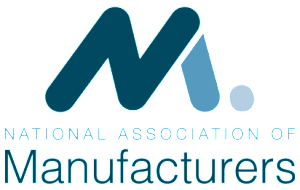Given all the political talk about creating jobs, and manufacturing jobs in particular, we wondered what our principal manufacturing advocacy group was doing. That group is the  National Association of Manufacturers (NAM), which has some 14,000 manufacturers as members.
National Association of Manufacturers (NAM), which has some 14,000 manufacturers as members.
We found numerous valuable items in the State of Manufacturing tour speeches by Jay Timmons, NAM’s president and CEO. In a 7 city tour in early 2016, Mr. Timmons spoke about manufacturing in America, with many specifics from the NAM Agenda for Economic Growth and American Exceptionalism.
On the NAM website, https://www.nam.org/, you can find a gold mine of useful information. Mr. Timmon’s State of Manufacturing tour speeches are available, along with “Competing to Win”, the NAM agenda that is guided by these four core values: free markets, competitiveness, individual liberty, and equal opportunity. The website has details about these four.
“Competing to Win” is a policy roadmap that expresses the priorities of manufacturers in the United States. The strategy contained in this plan would strengthen our industry and open new doors of opportunity for all Americans. “Competing to Win”, which is downloadable from the NAM website, lists 11 areas of emphasis and describes policy issues for each. The 11 areas are:
- tax;
- trade;
- energy;
- environment;
- transportation and infrastructure;
- labor;
- immigration;
- workforce;
- healthcare;
- research, innovation and technology; and
- regulatory and legal reform.
In addition to “Competing to Win” and the State of Manufacturing tour speeches, you will also find “Top 20 Facts About Manufacturing”. A few takeaways:
- The vast majority of manufacturing firms in the US are quite small. In the most recent data, there were 256,363 manufacturing firms. A mere 1.4% of these had over 500 employees, and 75% had fewer than 20 employees.
- There are 12+ million manufacturing workers in the US, accounting for 9% of the workforce. For reference, the high point of US manufacturing employment was 21 million in 1979 (this from Saving American Manufacturing by Michael Collins)
- In 2014, the average manufacturing worker in the US earned $79,553 annually, including pay and benefits. The average worker in all industries earned $64,204. Looking specifically at wages, the average manufacturing worker earned $25.19 per hour, according to the latest figures, not including benefits.
- [Of interest, these data differ from that of the US Bureau of Labor Statistics, who report: “Wages in Manufacturing in the United States increased to 20.16 USD/Hour in February from 20.14 USD/Hour in January of 2016”.]
- Over the next decade, nearly 3.5 million manufacturing jobs will likely be needed, and 2 million are expected to go unfilled due to the skills gap. Moreover, according to a recent report, 80% of manufacturers report a moderate or serious shortage of qualified applicants for skilled and highly skilled production positions.
- Manufactured goods exports have grown substantially to our largest trading partners since 1990, including to Canada, Mexico, and even China. Moreover, free trade agreements (FTS’s) are an important tool for opening new markets, with 52% of manufactured goods exports flowing to our FTA partners in 2014. The US enjoys a $55 billion manufacturing trade surplus with its trade agreement partners, compared with a $579 billion deficit with other countries.
- Manufacturers in the US perform more than 75% of all private sector R&D in the nation, driving more innovation than any other sector. The major industries involved in this R&D are pharmaceuticals, aerospace, chemicals, computers, electronics, and motor vehicles.
It is widely noted that R&D and innovation is closely tied to manufacturing, and a very big reason why things like reshoring are so very important in the long haul. - The cost of federal regulations falls disproportionately on manufacturers, particularly those that are smaller. Manufacturers pay $19,564 per employee per year on average to comply with federal regulations, or nearly double the $9991 per employee per year borne by all firms as a whole. Environmental regulations account for 90% of the difference in compliance costs between manufacturers and the average firm.
We note the NAM’s statistical specifics are not clearly referenced, and apparently somewhat different than other sources we found. However, the general thrust of the “Top 20 Facts About Manufacturing” presents a vivid picture of the importance of manufacturing in the US. We believe the NAM’s website to be worthy of your investigation. After all, the NAM is a very loud voice that represents most of us, whether members or not, and can influence legislation that affects us all.

